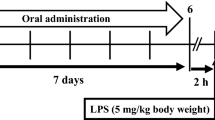Abstract
Macrophages participate in several inflammatory pathologies such as sepsis and arthritis. We investigated the effect of silkworm hemolymph (SH) on the LPS-induced pro-inflammatory macrophages. SH inhibits LPS-induced nitric oxide (NO) production in RAW 264.7 cells and murine peritoneal macrophages. The decreased NO was reflected as a decreased amount of inducible nitric oxide synthase (iNOS) mRNA and protein. It was also found that SH inhibited pro-inflammatory cytokines, IL-1β, IL-6, and TNF-α production. To elucidate the mechanism by which SH inhibits NO production and iNOS expression, we investigated that SH suppressed IκB phosphorylation, which leads to the activation of NF-κB followed by degradation of IκB. This observation suggests that SH is a potential therapeutic modulator for inflammation-associated disorders.
Similar content being viewed by others
References
C. A. Janeway, Jr. and R. Medzhitov, Annu. Rev. Immunol., 20, 197 (2002).
C. R. Raetz and C. Whitfield, Annu. Rev. Biochem., 71, 635 (2002).
A. Petros, D. Bennett and P. Vallance, Lancet, 338, 1557 (1991).
J. Cohen, Nature, 420, 885 (2002).
J. C. ter Steege, M. W. van de Ven, P. P. Forget, P. Brouckaert and W. A. Buurman, Cytokine, 10, 115 (1998).
H. Cheon, S. J. Yu, D. H. Yoo, I. J. Chae, G.G. Song and J. Sohn, Clin. Exp. Immunol., 127, 547 (2002).
Q. W. Xie, Y. Kashiwabara and C. Nathan, J. Biol. Chem., 269, 4705 (1994).
W. C. Sha, H.C. Liou, E. I. Tuomanen and D. Baltimore, Cell, 80, 321 (1995).
S. H. Ha, T. H. Park and S. E. Kim, Biotechnol. Technol., 10, 401 (1996).
W. J. Rhee, E. J. Kim and T. H. Park, Biotechnol. Prog., 15, 1028 (1999).
S. H. Ha and T. H. Park, Biotechnol. Lett., 19, 1087 (1997).
W. J. Rhee and T. H. Park, Biochem. Biophys. Res. Commun., 271, 186 (2002).
S. S. Choi, W. J. Rhee and T. H. Park, Biotechnol. Prog., 18, 874 (2002).
W. J. Rhee, E. J. Kim and T.H. Park, Biophys. Res. Commun., 295, 779 (2002).
E. J. Kim, W. J. Rhee and T. H. Park, Biochem. Biophys. Res. Commun., 285, 224 (2001).
E. J. Kim, W. J. Rhee and T. H. Park, Biotechnol. Prog., 20, 324 (2004).
E. J. Kim, H. J. Park and T. H. Park, Biochem. Biophys. Res. Commun., 308, 523 (2003).
E. J. Kim and T. H. Park, Biotechnol. Bioprocess Eng., 8, 76 (2003).
S. S. Choi, W. J. Rhee, E. J. Kim and T. H. Park, Biotechnol. Bioeng., 95, 459 (2006).
Z. Wang, J.H. Park, H. H. Park, W. Tan and T. H. Park, Biotechnol. Bioeng., 108, 1634 (2011).
J. H. Park, Z. Wang, H.-J. Jeong, H. H. Park, B.-G. Kim, W.-S. Tan, S. S. Choi and T. H. Park, Appl. Microbiol. Biotechnol., 96, 671 (2012).
C. E. Joosten, T. H. Park and M. L. Shuler, Biotechnol. Bioeng., 83, 695 (2003).
S. S. Choi, W. J. Rhee and T. H. Park, Biotechnol. Bioeng., 91, 793 (2005).
W. J. Rhee, E. H. Lee and T. H. Park, Biotechnol. Bioprocess Eng., 14, 645 (2009).
W. J. Rhee, E.H. Lee, J. H. Park, J. E. Lee and T.H. Park, Biotechnol. Prog., 23, 1441 (2007).
F. D’Acquisto, M. J. May and S. Ghosh, Mol. Interv., 2, 22 (2002).
H. F. Starnes, Jr., M. K. Pearce, A. Tewari, J. H. Yim, J.C. Zou and J. S. Abrams, J. Immunol., 145, 4185 (1990).
B. J. Rollins, Mol. Med. Today, 2, 198 (1996).
L. Van Kaer, Immunol. Cell Biol., 82, 315 (2004).
S. Ghosh, M. J. May and E.B. Kopp, Annu. Rev. Immunol., 16, 225 (1998).
J. Xaus, M. Comalada, A. F. Valledor, J. Lioberas, F. Lopez-Soriano, J.M. Argiles, C. Bogdan and A. Celada, Blood, 15, 3823 (2000).
N. Koizumi, A. Morozumi, M. Imamura, E. Tanaka, H. Iwahana and R. Sato, Eur. J. Biochem., 248, 217 (1997).
N. Koizumi, M. Imamura, T. Kadotani, K. Yaoi, H. Iwahana and R. Sato, FEBS Lett., 443, 139 (1999).
M. Kamimura, Y. Nakahara, Y. Kanamori, S. Tsuzuki, Y. Hayakawa and M. Kiuchi, Biochem. Biophys. Res. Commun., 286, 67 (2001).
K. Ishii, H. Hamamoto, M. Kamimura, Y. Nakamura, H. Noda, K. Imamura, K. Mita and K. Sekimizu, J. Biol. Chem., 285, 28635 (2010).
Author information
Authors and Affiliations
Corresponding author
Rights and permissions
About this article
Cite this article
Chang, MR., Lee, W.H., Rhee, W.J. et al. Anti-inflammatory effects of silkworm hemolymph on lipopolysaccharide-stimulated macrophages. Korean J. Chem. Eng. 30, 1784–1789 (2013). https://doi.org/10.1007/s11814-013-0108-6
Received:
Accepted:
Published:
Issue Date:
DOI: https://doi.org/10.1007/s11814-013-0108-6




